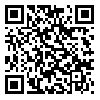Volume 19, Issue 2 (June-Biomaterials Special Issue- 2022)
IJMSE 2022, 19(2): 1-7 |
Back to browse issues page
Abstract: (5325 Views)
Abstract
Gelatin (GEL) is most extensively used in various fields, particularly in therapeutics and pharmaceuticals. GEL was extracted from goat skin using hot temperature extraction process and compared with that of commercial GEL. The physico-chemical characterization and functional properties were investigated by using temperature denaturation (Td), water-holding and fat-binding capacities (WHC and FBC), colour measurement and UV-light spectrum. In vitro biocompatibility was studied for the first time and was evaluated by blood coagulation index (BCI) and haemolytic tests for using as wounds dressing. The results revealed thermal stability of goat GEL at Td 37°C. WHC and FBC capacities represented 2.5 and 1.2 g/ml, respectively. The hunter colour spaces a*, b* and L* showed a -0.27, -1.97 and 25.23 values, respectively. UV-Vis absorption spectrum of the goat GEL showed a maximum absorption peak at 280 nm. The in vitro anticoagulant activities of extracting GEL were higher than 70% after incubation for one hour. After being in contact with red blood cells for 1 h, the haemolysis ratio increased from to 0.46 to 1.4 when the concentration of goat GEL increased from 1 to 50 mg/ml suggesting the safety of the tested samples. These results suggest that thromboresistivity and hemocompatibility of this biopolymer retained the biological activity of our samples for biomaterial applications. According to this, goat GEL successfully competes with, and significantly could be useful for substitution of bovine in wound healing.
Gelatin (GEL) is most extensively used in various fields, particularly in therapeutics and pharmaceuticals. GEL was extracted from goat skin using hot temperature extraction process and compared with that of commercial GEL. The physico-chemical characterization and functional properties were investigated by using temperature denaturation (Td), water-holding and fat-binding capacities (WHC and FBC), colour measurement and UV-light spectrum. In vitro biocompatibility was studied for the first time and was evaluated by blood coagulation index (BCI) and haemolytic tests for using as wounds dressing. The results revealed thermal stability of goat GEL at Td 37°C. WHC and FBC capacities represented 2.5 and 1.2 g/ml, respectively. The hunter colour spaces a*, b* and L* showed a -0.27, -1.97 and 25.23 values, respectively. UV-Vis absorption spectrum of the goat GEL showed a maximum absorption peak at 280 nm. The in vitro anticoagulant activities of extracting GEL were higher than 70% after incubation for one hour. After being in contact with red blood cells for 1 h, the haemolysis ratio increased from to 0.46 to 1.4 when the concentration of goat GEL increased from 1 to 50 mg/ml suggesting the safety of the tested samples. These results suggest that thromboresistivity and hemocompatibility of this biopolymer retained the biological activity of our samples for biomaterial applications. According to this, goat GEL successfully competes with, and significantly could be useful for substitution of bovine in wound healing.
Type of Study: Research Paper |
Subject:
Synthesis and preparation of materials to meet the requirements of AM techniques
| Rights and permissions | |
 |
This work is licensed under a Creative Commons Attribution-NonCommercial 4.0 International License. |



